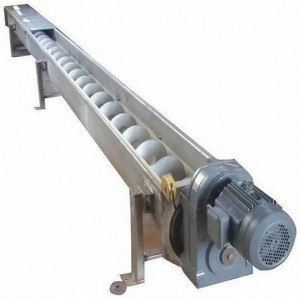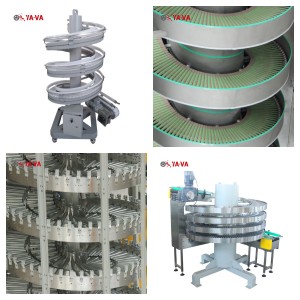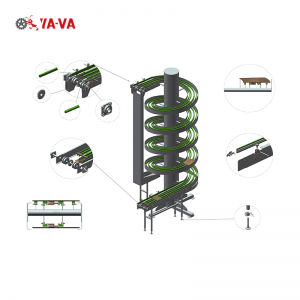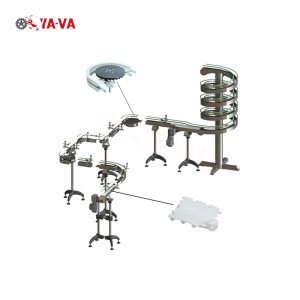What is the difference between a screw conveyor and a spiral conveyor?
1. Basic Definition
- Screw Conveyor: A mechanical system that uses a rotating helical screw blade (called a "flight") inside a tube or trough to move granular, powdered, or semi-solid materials horizontally or at a slight incline.
- Spiral Conveyor: A type of vertical or inclined conveyor that uses a continuous spiral blade to lift materials between different levels, commonly used in food, chemical, and packaging industries.
2. Key Differences
| Feature | Screw Conveyor | Spiral Conveyor |
|---|---|---|
| Primary Function | Moves materials horizontally or at low inclines (up to 20°). | Moves materials vertically or at steep angles (30°–90°). |
| Design | Typically enclosed in a U-shaped trough or tube with a rotating screw. | Uses an enclosed spiral blade rotating around a central shaft. |
| Material Handling | Best for powders, grains, and small granules. | Used for lightweight items (e.g., bottles, packaged goods). |
| Capacity | Higher capacity for bulk materials. | Lower capacity, suited for package 、cartoon、bottled、sacks |
| Speed | Moderate speed (adjustable). | Generally slower for precise elevation.Mainly according customized |
| Maintenance | Requires lubrication; prone to wear in abrasive applications. | Easier to clean (common in food processing). |
| Common Uses | Agriculture, cement, wastewater treatment. | Food & beverage, pharmaceuticals, packaging. |
3. When to Use Which?
- Choose a Screw Conveyor if:
- You need to move bulk materials (e.g., grain, cement, sludge) horizontally.
- High-volume transfer is required.
- The material is non-sticky and non-abrasive.
- Choose a Spiral Conveyor if:
- You need to corss-floor transport products vertically (e.g., bottles, packaged goods).
- Space is limited, and a compact design is needed.
- Sanitary, easy-to-clean surfaces are required (e.g., food industry).
4. Summary
- Screw Conveyor= Horizontal bulk material transport.
- Spiral Conveyor = Vertical lifting of lightweight items.
Both systems serve different purposes, and the best choice depends on material type, required movement, and industry needs.


How does a spiral conveyor work?
1. Basic Principle
A spiral conveyor moves products *vertically* (up or down) using a rotating **helical blade** (spiral) inside a stable frame. It is commonly used for **lifting or lowering items** between different levels in production lines.
2. Main Components
- Spiral Blade: A steel or plastic helix that rotates to push products upward/downward.
- Central Shaft: Supports the spiral blade and connects to the motor.
- Drive System: An electric motor with gearbox controls rotation speed.
- Frame/Guides: Keeps products aligned during movement (open or enclosed design).
3. How It Operates
1. Product Entry – Items are fed onto the spiral at the bottom(for lifting) or top (for lowering).
2. Spiral Rotation – The motor turns the spiral blade, creating a continuous upward/downward push.
3. Controlled Movement– Products slide or glide along the spiral path, guided by side rails.
4. Discharge – Items exit smoothly at the desired level without tipping or jamming.
4. Key Features
- Space-Saving: No need for multiple conveyors—just a compact vertical loop.
- Gentle Handling: Smooth motion prevents product damage (used for bottles, food, etc.).
- Adjustable Speed: Motor controls allow precise flow rate adjustments.
- Low Maintenance: Few moving parts, easy to clean (common in food & pharma industries).
5. Common Uses
- Food & Beverage: Moving packaged goods, bottles, or baked goods between floors.
- Packaging: Elevating boxes, cans, or cartons in production lines.
- Pharmaceuticals: Transporting sealed containers without contamination.
6. Advantages Over Elevators/Lifts
- Continuous flow (no waiting for batches).
- No belts or chains (reduces maintenance).
- Customizable height & speedfor different products.
Conclusion
A spiral conveyor provides an efficient, space-saving way to move products **vertically** in a smooth, controlled manner. It is ideal for industries needing gentle, continuous elevation without complex machinery.


Post time: May-15-2025



